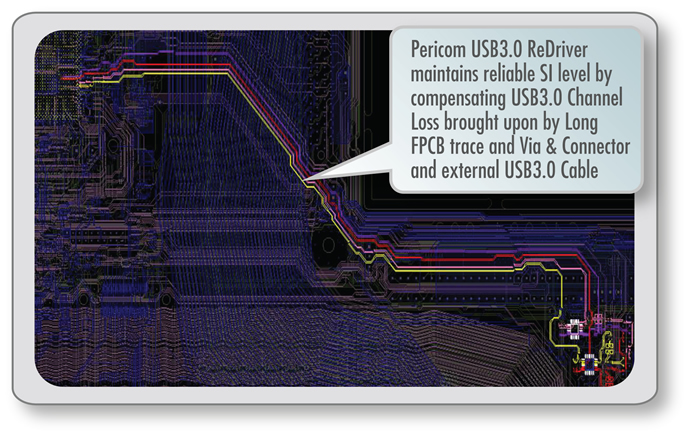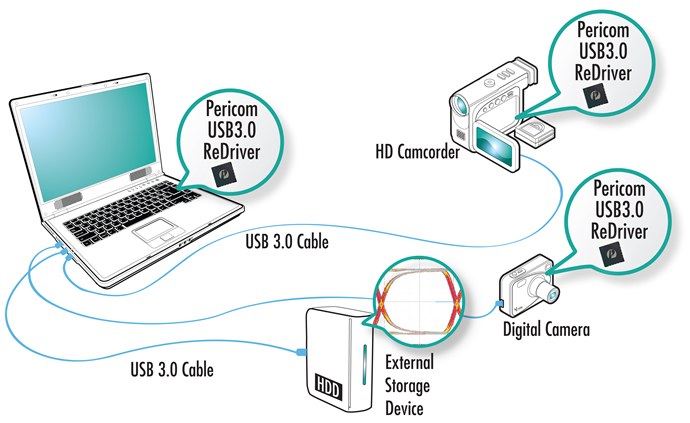A look at redrivers in mobile devices
Mobile phones need high speed serial links, but many of these links will not work without the help of a redriver. That is because at multi-gigabit speeds, transmission line effects become important and signals degrade, often to the point of no longer meeting electrical specifications. As Pericom explain, there are a number of signal loss effects that impact the serial link in small footprint mobile platforms.
Because of the very small PCB footprint and closeness of circuitry, noise induced jitter from clocks and other nearby sources take signals out of sync. In ultra-mobile devices with high speed serial interfaces, signal integrity (SI) is a major design consideration. These gigahertz frequencies cause problems of crosstalk on adjacent traces, in buried PCB layers, or with non-back drilled PCB stubs.
In addition, today’s smaller, die-shrunk processors, SoCs and intelligent peripherals found in space constrained mobile devices have a lower output drive voltage, so gigahertz signals cannot travel as far without degrading due to lower swing ranges.
If low drive coupled with crosstalk and jitter was not bad enough, the small motherboards and daughter cards found in ultra-mobile platforms create signal routing problems. Savvy SI designers still have to route near noisy EMI sources such as RF circuits or antennas. As well, multiple circuit boards connected via flexible circuits (FPCB) and internal cables force these weaker, cross-affected and attenuated gigahertz serial signals to traverse multiple electrical boundary connections, each one causing reflections and further attenuation. Add all of these signal loss effects up, and it is no wonder that small PCBs suffer as much if not more SI issues than much larger motherboards.
However, there is hope. redrivers are small footprint active amplifiers that clean up and boost signals, recovering the margin and quality lost due to SI problems (Fig. 1). Redrivers from signal integrity specialists such as Diodes-Pericom are used in all kinds of portable devices - from smartphones to tablets - and recover generic gigahertz signals.

Fig. 1: long USB 3.0 traces on a dense ultra-mobility device PCB need redrivers to clean up signals
More commonly, redrivers work with one or more protocols such as USB3, SATA, DisplayPort, HDMI or PCI Express. By tailoring the redrivers to the interface and protocol standard, optimal performance is achieved in terms of compliance at the connector. Specifically in USB 3.0 systems, as shown in Fig. 2, redrivers work internally and externally to assure strong SI.

Fig. 2: USB 3.0 redrivers used inside and outside ultra-mobile devices
Positives
Among the main reasons for using USB 3 redrivers in mobile phones is to compensate for the low output drive from the baseband CPU chipset and for the high loss flexible PCBs that are typically used in these small footprints.
However, more importantly, they can reduce EMI as the 5Gbps USB 3 signal travels across the phone PCB, by placing the redriver right at the USB 3 connector at the bottom of the phone.
Phone and tablet I/O links are typically designed for tight spacing and wired around the battery pack. The camera and USB ports are usually on the top and bottom of the system. Normally, the SoC would be placed close to the camera due to Mipi-CSI2 requirements. The SoC to USB port is then connected through a flexible PCB with proprietary connectors.
Putting the redriver at the connector, rather than at the CPU side, helps to reduce EMI and interference with the 2.5GHz LTE signals also present in the phone. It offsets channel loss from the flexible PCB cable or connector to maintain good SI in a phone or tablet.
The 2.5GHz clock rate of the USB 3 data rate - the USB 3 data rate is twice the clock rate since it is double clocked, equal to 5Gbps - causes interference with the approximately 2.5GHz LTE RF radio frequency of the mobile phone. So redriver placement can help with this. They also provide the drive capability for the USB 3 signal across the 3m cable to meet USBIF compliance testing.
Devices
Diodes-Pericom has redrivers designed for these types of mobile applications. For example, the company’s PI1EQX512A is a low power USB3.1 Gen1 (5Gbps) redriver and repeater with 1V VDD, using a 2 x 2mm package for small, low profile computing platforms, including ultra-books, tablets, two-in-one PCs, monitors, docking stations and smartphones. The IC has two channels (one USB port), programmable equalisation, and fully USB power management compliant features that enable the part to achieve the power saving modes required by the system.
Likewise, the PI2EQX510E is a low power, high performance 5.0Gbps signal redriver for the USB 3.0 protocol. The device provides programmable equalisation and de-emphasis to optimise performance over various physical mediums by reducing inter-symbol interference. It supports 100Ω differential CML data I/Os between the protocol ASIC and a switch fabric, over cable, or to extend the signals across other distant data pathways on the user’s platform. The integrated equalisation circuitry provides flexibility with signal integrity of the signal before the redriver. A low level input signal detection and output squelch function is provided. The channels’ input signal level determines whether the output is active.
Conclusion
The noisy atmosphere in a mobile phone, laptop or tablet can be a nightmare for RF designers. This can cause serious, fatal disruption of the high speed signal links. However, products do exist, such as the redrivers talked about here, that can help the engineer design the device in such a way that signal integrity is maintained.






